CSU-Global: The 2015 Nepal Earthquake - Environmental & Societal
VerifiedAdded on 2023/06/10
|5
|1024
|237
Report
AI Summary
This report examines the devastating Nepal earthquake of April 2015, focusing on its environmental, economic, and social impacts. The earthquake, a magnitude 7.8 event, resulted in approximately 9,000 deaths, widespread destruction of infrastructure, and significant environmental damage, including landslides and avalanches. The report discusses the earthquake's effects on the country's economy, particularly the agriculture and tourism sectors, and the social upheaval that followed, including increased vulnerability to exploitation and abuse. It also explains the geological context of the earthquake, linking it to the convergence of the Eurasian and Indian tectonic plates. The report concludes by highlighting lessons learned from the disaster, emphasizing the importance of earthquake preparedness and resilient infrastructure. Desklib offers a variety of resources, including past papers and solved assignments, to aid students in their studies.
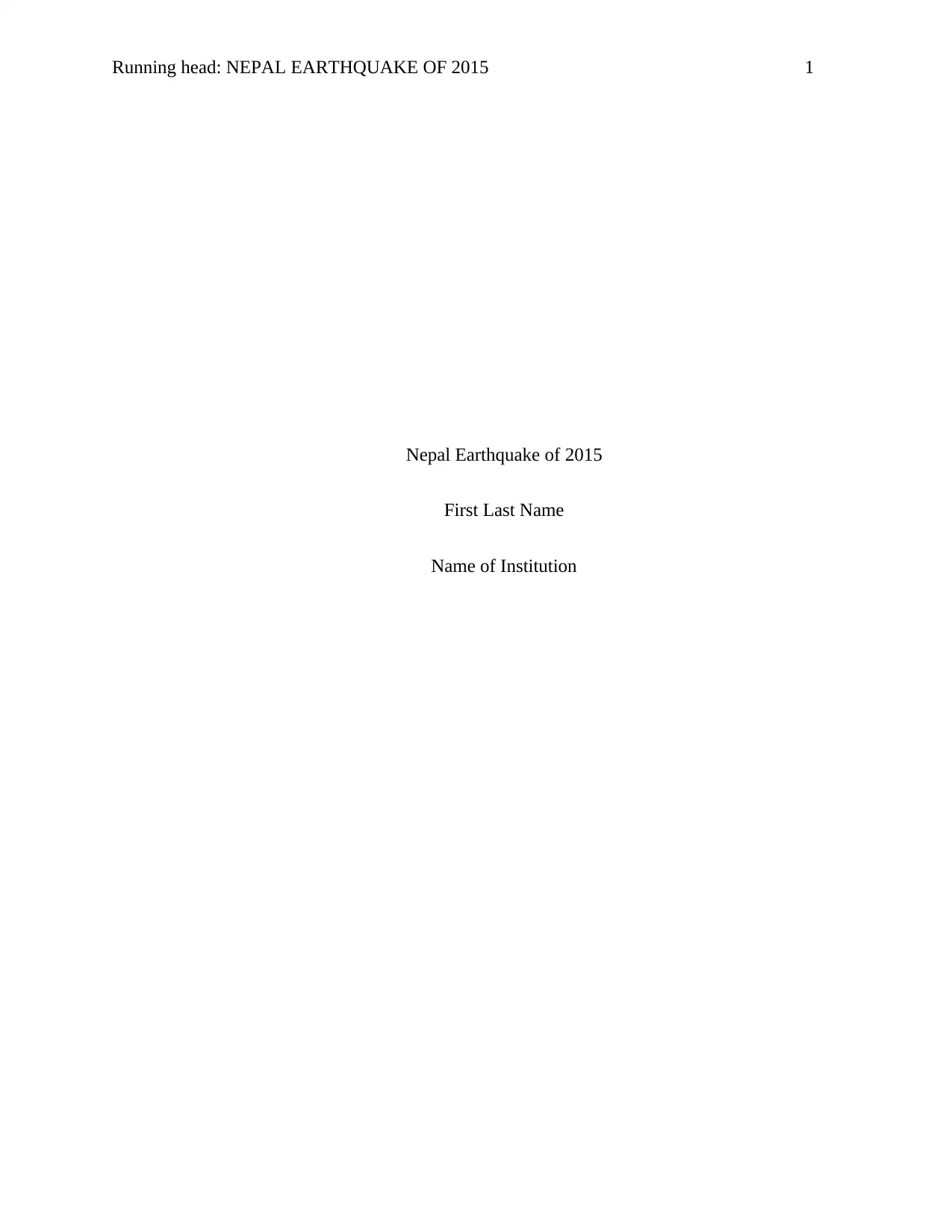
Running head: NEPAL EARTHQUAKE OF 2015 1
Nepal Earthquake of 2015
First Last Name
Name of Institution
Nepal Earthquake of 2015
First Last Name
Name of Institution
Paraphrase This Document
Need a fresh take? Get an instant paraphrase of this document with our AI Paraphraser
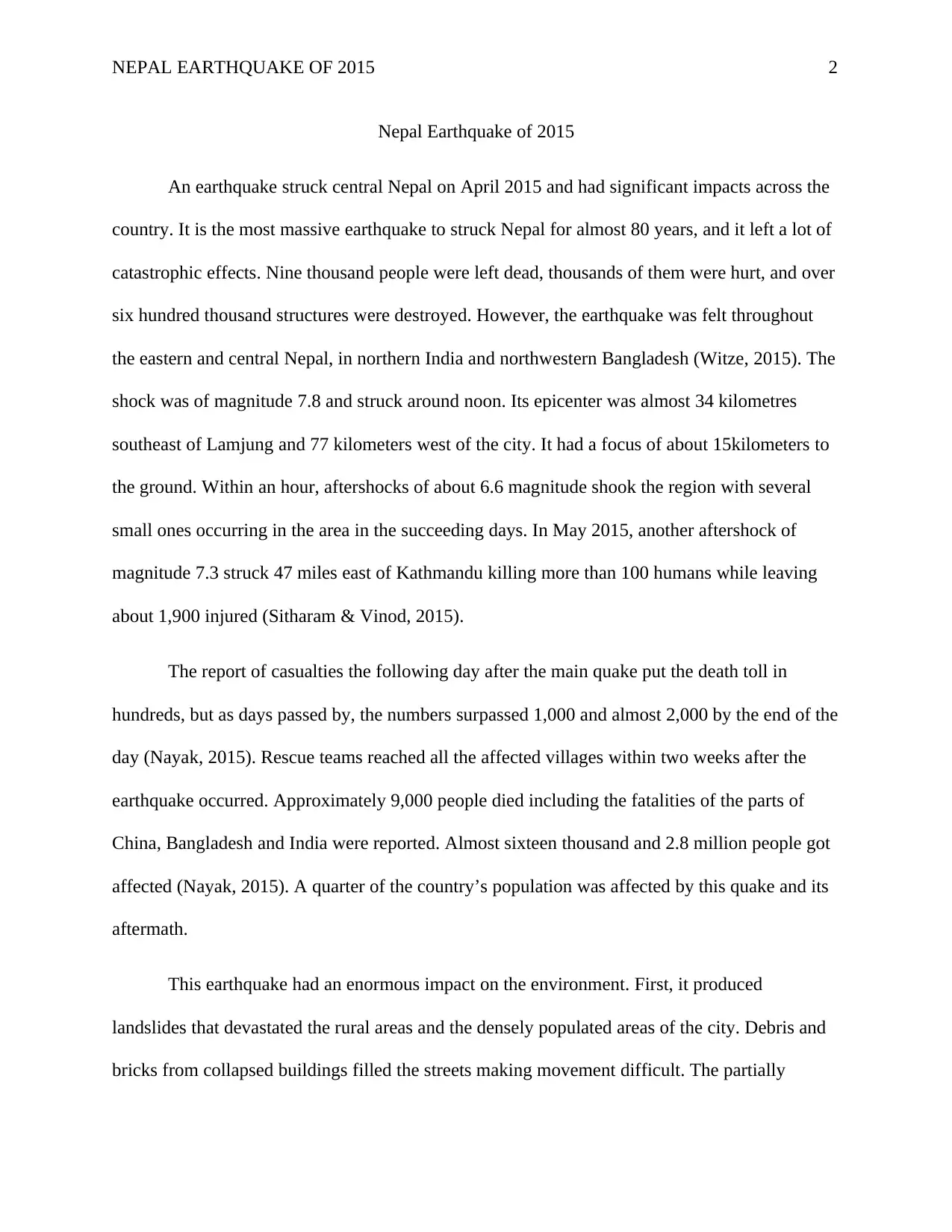
NEPAL EARTHQUAKE OF 2015 2
Nepal Earthquake of 2015
An earthquake struck central Nepal on April 2015 and had significant impacts across the
country. It is the most massive earthquake to struck Nepal for almost 80 years, and it left a lot of
catastrophic effects. Nine thousand people were left dead, thousands of them were hurt, and over
six hundred thousand structures were destroyed. However, the earthquake was felt throughout
the eastern and central Nepal, in northern India and northwestern Bangladesh (Witze, 2015). The
shock was of magnitude 7.8 and struck around noon. Its epicenter was almost 34 kilometres
southeast of Lamjung and 77 kilometers west of the city. It had a focus of about 15kilometers to
the ground. Within an hour, aftershocks of about 6.6 magnitude shook the region with several
small ones occurring in the area in the succeeding days. In May 2015, another aftershock of
magnitude 7.3 struck 47 miles east of Kathmandu killing more than 100 humans while leaving
about 1,900 injured (Sitharam & Vinod, 2015).
The report of casualties the following day after the main quake put the death toll in
hundreds, but as days passed by, the numbers surpassed 1,000 and almost 2,000 by the end of the
day (Nayak, 2015). Rescue teams reached all the affected villages within two weeks after the
earthquake occurred. Approximately 9,000 people died including the fatalities of the parts of
China, Bangladesh and India were reported. Almost sixteen thousand and 2.8 million people got
affected (Nayak, 2015). A quarter of the country’s population was affected by this quake and its
aftermath.
This earthquake had an enormous impact on the environment. First, it produced
landslides that devastated the rural areas and the densely populated areas of the city. Debris and
bricks from collapsed buildings filled the streets making movement difficult. The partially
Nepal Earthquake of 2015
An earthquake struck central Nepal on April 2015 and had significant impacts across the
country. It is the most massive earthquake to struck Nepal for almost 80 years, and it left a lot of
catastrophic effects. Nine thousand people were left dead, thousands of them were hurt, and over
six hundred thousand structures were destroyed. However, the earthquake was felt throughout
the eastern and central Nepal, in northern India and northwestern Bangladesh (Witze, 2015). The
shock was of magnitude 7.8 and struck around noon. Its epicenter was almost 34 kilometres
southeast of Lamjung and 77 kilometers west of the city. It had a focus of about 15kilometers to
the ground. Within an hour, aftershocks of about 6.6 magnitude shook the region with several
small ones occurring in the area in the succeeding days. In May 2015, another aftershock of
magnitude 7.3 struck 47 miles east of Kathmandu killing more than 100 humans while leaving
about 1,900 injured (Sitharam & Vinod, 2015).
The report of casualties the following day after the main quake put the death toll in
hundreds, but as days passed by, the numbers surpassed 1,000 and almost 2,000 by the end of the
day (Nayak, 2015). Rescue teams reached all the affected villages within two weeks after the
earthquake occurred. Approximately 9,000 people died including the fatalities of the parts of
China, Bangladesh and India were reported. Almost sixteen thousand and 2.8 million people got
affected (Nayak, 2015). A quarter of the country’s population was affected by this quake and its
aftermath.
This earthquake had an enormous impact on the environment. First, it produced
landslides that devastated the rural areas and the densely populated areas of the city. Debris and
bricks from collapsed buildings filled the streets making movement difficult. The partially
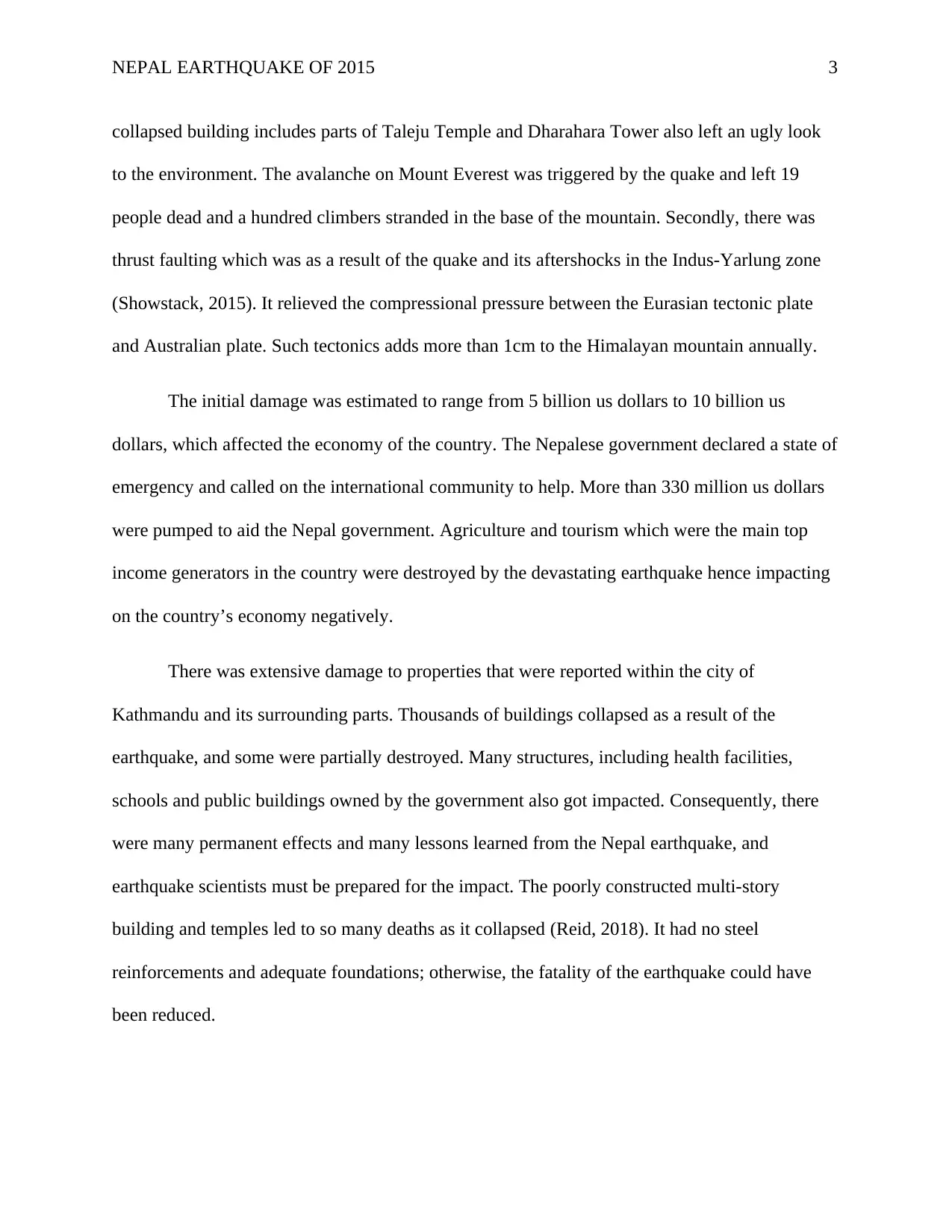
NEPAL EARTHQUAKE OF 2015 3
collapsed building includes parts of Taleju Temple and Dharahara Tower also left an ugly look
to the environment. The avalanche on Mount Everest was triggered by the quake and left 19
people dead and a hundred climbers stranded in the base of the mountain. Secondly, there was
thrust faulting which was as a result of the quake and its aftershocks in the Indus-Yarlung zone
(Showstack, 2015). It relieved the compressional pressure between the Eurasian tectonic plate
and Australian plate. Such tectonics adds more than 1cm to the Himalayan mountain annually.
The initial damage was estimated to range from 5 billion us dollars to 10 billion us
dollars, which affected the economy of the country. The Nepalese government declared a state of
emergency and called on the international community to help. More than 330 million us dollars
were pumped to aid the Nepal government. Agriculture and tourism which were the main top
income generators in the country were destroyed by the devastating earthquake hence impacting
on the country’s economy negatively.
There was extensive damage to properties that were reported within the city of
Kathmandu and its surrounding parts. Thousands of buildings collapsed as a result of the
earthquake, and some were partially destroyed. Many structures, including health facilities,
schools and public buildings owned by the government also got impacted. Consequently, there
were many permanent effects and many lessons learned from the Nepal earthquake, and
earthquake scientists must be prepared for the impact. The poorly constructed multi-story
building and temples led to so many deaths as it collapsed (Reid, 2018). It had no steel
reinforcements and adequate foundations; otherwise, the fatality of the earthquake could have
been reduced.
collapsed building includes parts of Taleju Temple and Dharahara Tower also left an ugly look
to the environment. The avalanche on Mount Everest was triggered by the quake and left 19
people dead and a hundred climbers stranded in the base of the mountain. Secondly, there was
thrust faulting which was as a result of the quake and its aftershocks in the Indus-Yarlung zone
(Showstack, 2015). It relieved the compressional pressure between the Eurasian tectonic plate
and Australian plate. Such tectonics adds more than 1cm to the Himalayan mountain annually.
The initial damage was estimated to range from 5 billion us dollars to 10 billion us
dollars, which affected the economy of the country. The Nepalese government declared a state of
emergency and called on the international community to help. More than 330 million us dollars
were pumped to aid the Nepal government. Agriculture and tourism which were the main top
income generators in the country were destroyed by the devastating earthquake hence impacting
on the country’s economy negatively.
There was extensive damage to properties that were reported within the city of
Kathmandu and its surrounding parts. Thousands of buildings collapsed as a result of the
earthquake, and some were partially destroyed. Many structures, including health facilities,
schools and public buildings owned by the government also got impacted. Consequently, there
were many permanent effects and many lessons learned from the Nepal earthquake, and
earthquake scientists must be prepared for the impact. The poorly constructed multi-story
building and temples led to so many deaths as it collapsed (Reid, 2018). It had no steel
reinforcements and adequate foundations; otherwise, the fatality of the earthquake could have
been reduced.
⊘ This is a preview!⊘
Do you want full access?
Subscribe today to unlock all pages.

Trusted by 1+ million students worldwide
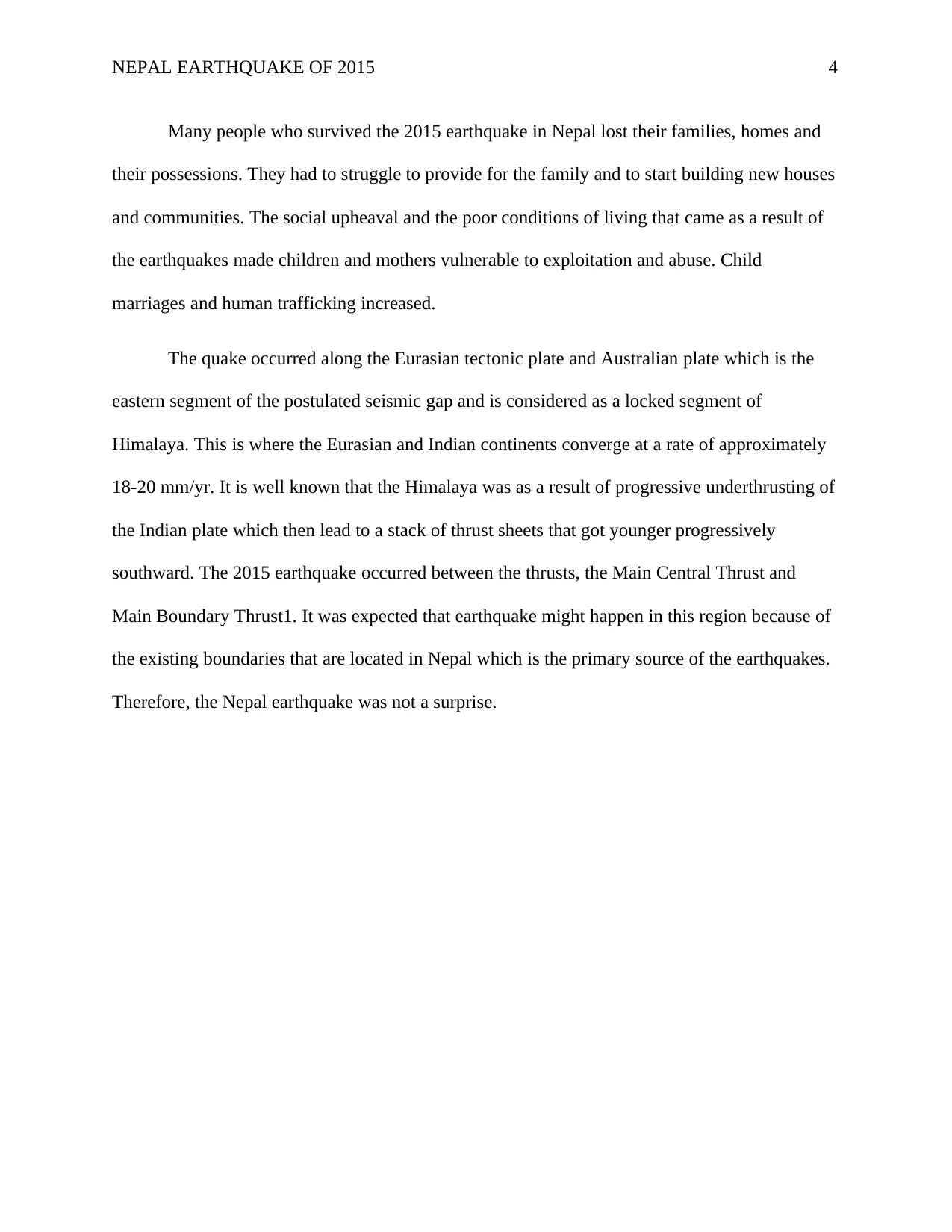
NEPAL EARTHQUAKE OF 2015 4
Many people who survived the 2015 earthquake in Nepal lost their families, homes and
their possessions. They had to struggle to provide for the family and to start building new houses
and communities. The social upheaval and the poor conditions of living that came as a result of
the earthquakes made children and mothers vulnerable to exploitation and abuse. Child
marriages and human trafficking increased.
The quake occurred along the Eurasian tectonic plate and Australian plate which is the
eastern segment of the postulated seismic gap and is considered as a locked segment of
Himalaya. This is where the Eurasian and Indian continents converge at a rate of approximately
18-20 mm/yr. It is well known that the Himalaya was as a result of progressive underthrusting of
the Indian plate which then lead to a stack of thrust sheets that got younger progressively
southward. The 2015 earthquake occurred between the thrusts, the Main Central Thrust and
Main Boundary Thrust1. It was expected that earthquake might happen in this region because of
the existing boundaries that are located in Nepal which is the primary source of the earthquakes.
Therefore, the Nepal earthquake was not a surprise.
Many people who survived the 2015 earthquake in Nepal lost their families, homes and
their possessions. They had to struggle to provide for the family and to start building new houses
and communities. The social upheaval and the poor conditions of living that came as a result of
the earthquakes made children and mothers vulnerable to exploitation and abuse. Child
marriages and human trafficking increased.
The quake occurred along the Eurasian tectonic plate and Australian plate which is the
eastern segment of the postulated seismic gap and is considered as a locked segment of
Himalaya. This is where the Eurasian and Indian continents converge at a rate of approximately
18-20 mm/yr. It is well known that the Himalaya was as a result of progressive underthrusting of
the Indian plate which then lead to a stack of thrust sheets that got younger progressively
southward. The 2015 earthquake occurred between the thrusts, the Main Central Thrust and
Main Boundary Thrust1. It was expected that earthquake might happen in this region because of
the existing boundaries that are located in Nepal which is the primary source of the earthquakes.
Therefore, the Nepal earthquake was not a surprise.
Paraphrase This Document
Need a fresh take? Get an instant paraphrase of this document with our AI Paraphraser
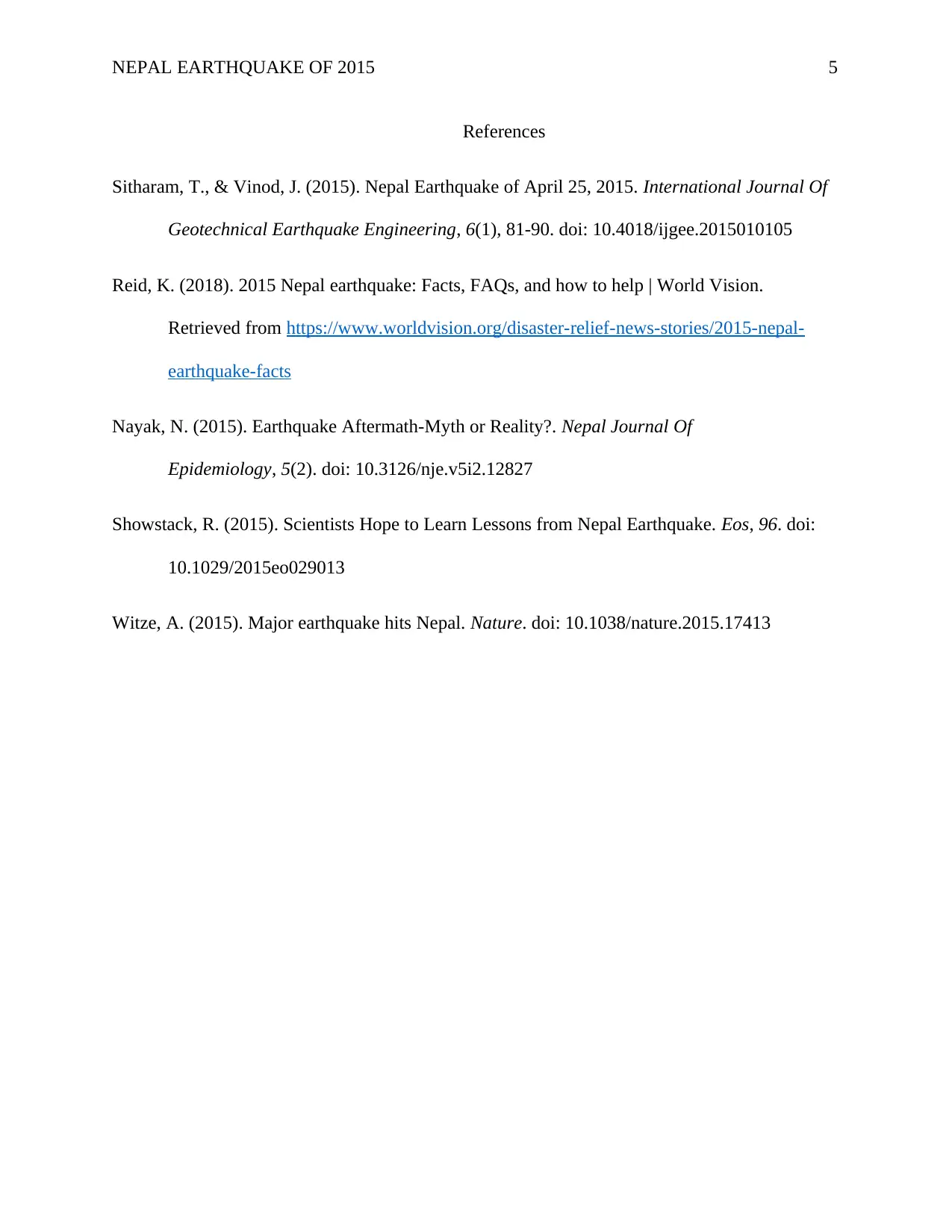
NEPAL EARTHQUAKE OF 2015 5
References
Sitharam, T., & Vinod, J. (2015). Nepal Earthquake of April 25, 2015. International Journal Of
Geotechnical Earthquake Engineering, 6(1), 81-90. doi: 10.4018/ijgee.2015010105
Reid, K. (2018). 2015 Nepal earthquake: Facts, FAQs, and how to help | World Vision.
Retrieved from https://www.worldvision.org/disaster-relief-news-stories/2015-nepal-
earthquake-facts
Nayak, N. (2015). Earthquake Aftermath-Myth or Reality?. Nepal Journal Of
Epidemiology, 5(2). doi: 10.3126/nje.v5i2.12827
Showstack, R. (2015). Scientists Hope to Learn Lessons from Nepal Earthquake. Eos, 96. doi:
10.1029/2015eo029013
Witze, A. (2015). Major earthquake hits Nepal. Nature. doi: 10.1038/nature.2015.17413
References
Sitharam, T., & Vinod, J. (2015). Nepal Earthquake of April 25, 2015. International Journal Of
Geotechnical Earthquake Engineering, 6(1), 81-90. doi: 10.4018/ijgee.2015010105
Reid, K. (2018). 2015 Nepal earthquake: Facts, FAQs, and how to help | World Vision.
Retrieved from https://www.worldvision.org/disaster-relief-news-stories/2015-nepal-
earthquake-facts
Nayak, N. (2015). Earthquake Aftermath-Myth or Reality?. Nepal Journal Of
Epidemiology, 5(2). doi: 10.3126/nje.v5i2.12827
Showstack, R. (2015). Scientists Hope to Learn Lessons from Nepal Earthquake. Eos, 96. doi:
10.1029/2015eo029013
Witze, A. (2015). Major earthquake hits Nepal. Nature. doi: 10.1038/nature.2015.17413
1 out of 5
Related Documents
Your All-in-One AI-Powered Toolkit for Academic Success.
+13062052269
info@desklib.com
Available 24*7 on WhatsApp / Email
![[object Object]](/_next/static/media/star-bottom.7253800d.svg)
Unlock your academic potential
Copyright © 2020–2025 A2Z Services. All Rights Reserved. Developed and managed by ZUCOL.




